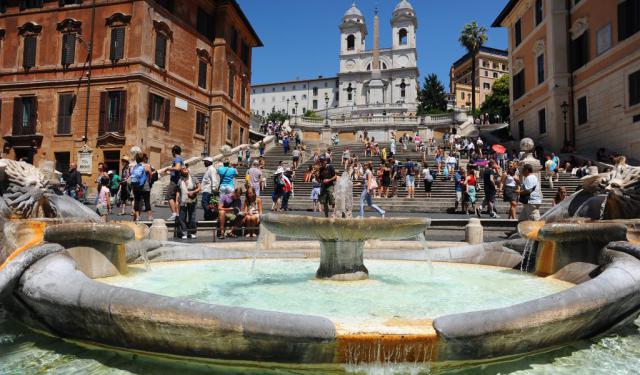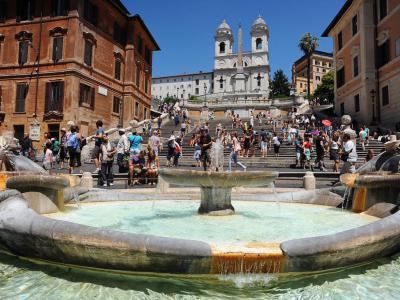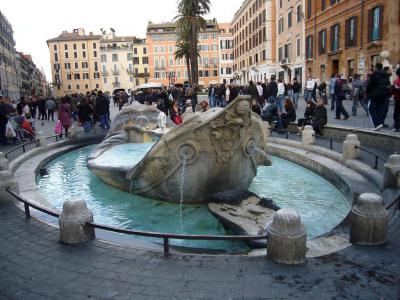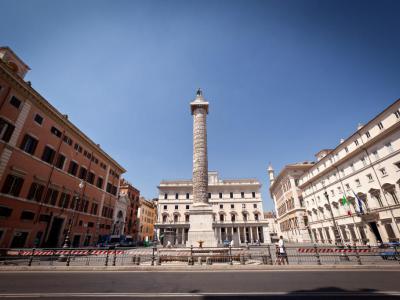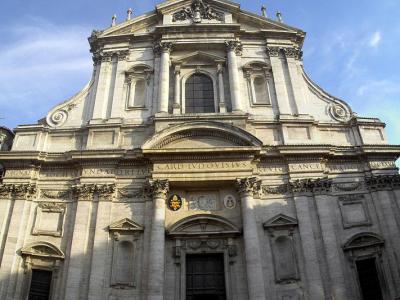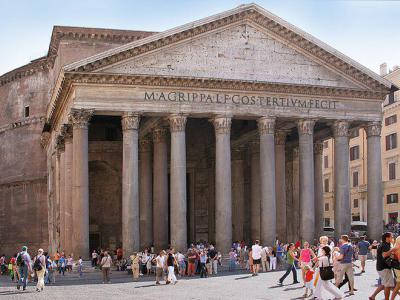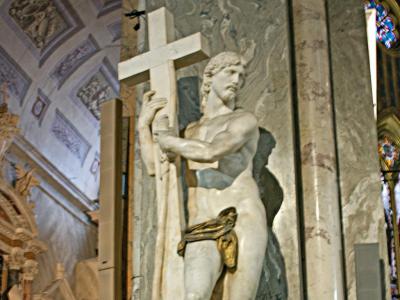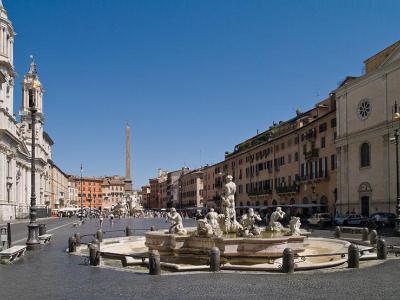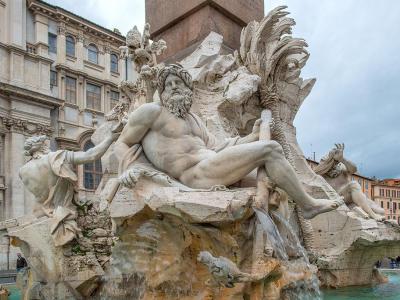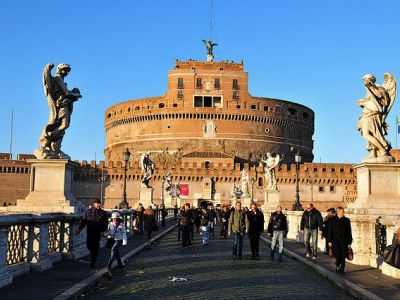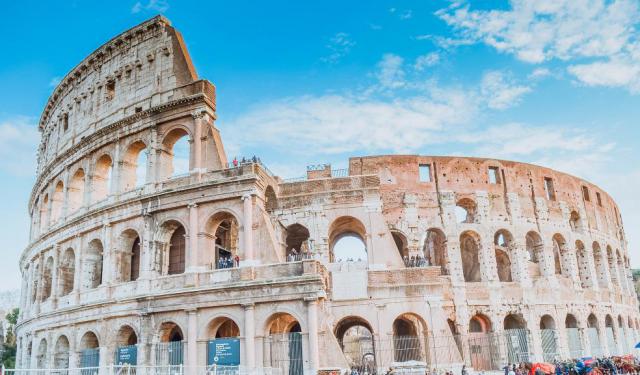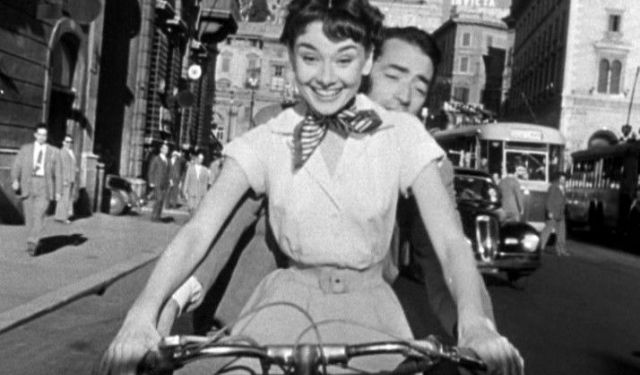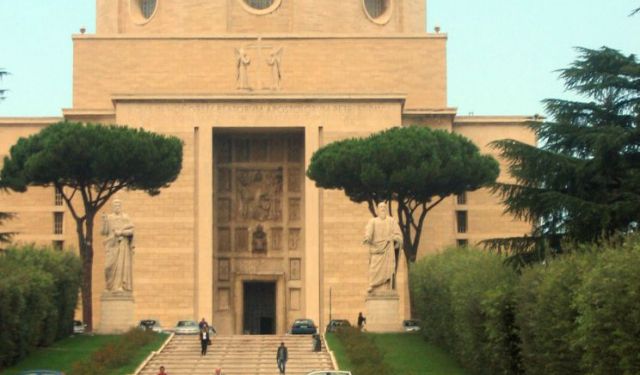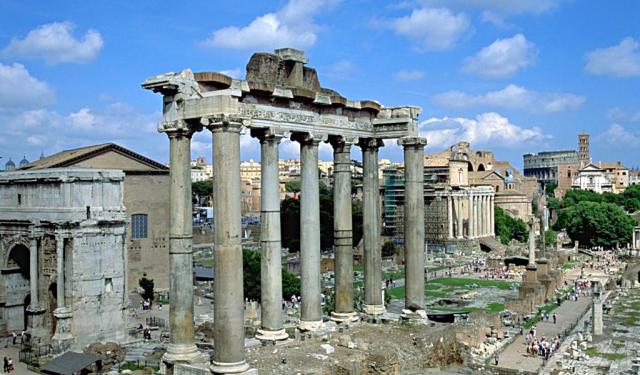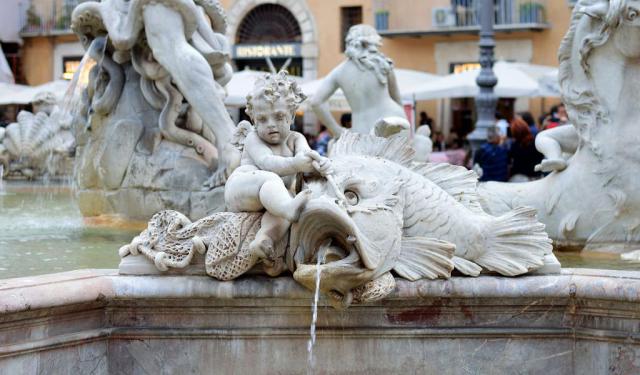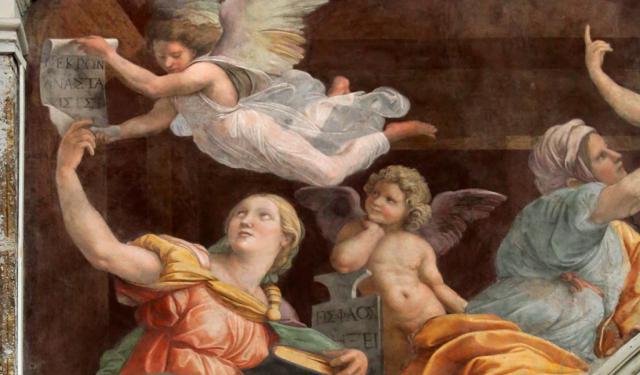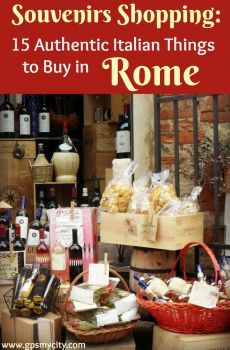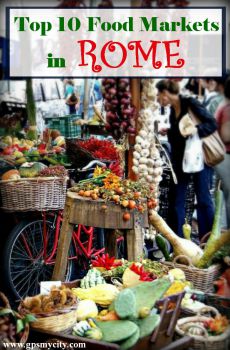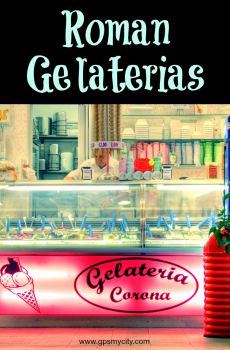Audio Guide: Rome Introduction Walking Tour II (Self Guided), Rome
Rome, the Eternal City, carries a legacy shaped by centuries of resilience, transformation, and cultural flourishing. The fall of the Roman Empire in 476 AD marked the end of an era, plunging Western Europe into the dark Middle Ages. Yet, even amid the disarray, Rome endured as a beacon of unity, largely due to its status as the center of Catholicism. The papacy wielded spiritual influence, offering a sense of continuity and cohesion to a fragmented world. This religious foundation would later serve as the catalyst for Rome’s breathtaking rebirth during the Renaissance and Baroque periods.
The Renaissance, born in Italy, found Rome embracing its ancient roots while pushing the boundaries of creativity in art, architecture, and religion. The Catholic Church became a significant patron of this cultural awakening, commissioning masterpieces that blended faith with innovation. The Baroque era then took this artistic revival to soaring heights, filling the city with dramatic, elaborate designs that reflected both divine inspiration and human ingenuity.
Exploring Rome today is like walking through a living museum, where each corner tells a story. Begin your journey at the Spanish Steps, a symbol of Baroque splendor, featuring at its foot the Spanish Square with the charming Longboat Fountain, shaped like a sinking vessel. Wander to Column Square, home to the Marcus Aurelius Column, an impressive monument to the ancient Roman emperor's victories.
The spiritual heart of the city beats in its churches, such as the Church of Saint Ignatius of Loyola, where Baroque frescoes create an illusion of a vaulted heaven, and the Basilica of Santa Maria above Minerva, one of Rome's few Gothic churches adorned with the likes of Michelangelo’s "Christ the Redeemer" sculpture. The Pantheon, with its stunning dome and oculus, is a timeless testament to Roman engineering and the city’s enduring dedication to its gods and saints.
In Navona Square, the Four Rivers Fountain, designed by Gian Lorenzo Bernini, captures the grandeur of Rome’s Baroque period. Meanwhile, the National Museum of Saint Angel's Castle, a fortress-turned-museum, offers breathtaking views and rich historical insights.
Rome is not just a city to visit; it’s an experience that unfolds layer by layer. Whether you’re an art enthusiast, history buff, or spiritual seeker, Rome invites you to immerse yourself in its timeless beauty. Pack your curiosity and explore this extraordinary tapestry of history, culture, and faith on our self-guided introductory walk part II.
The Renaissance, born in Italy, found Rome embracing its ancient roots while pushing the boundaries of creativity in art, architecture, and religion. The Catholic Church became a significant patron of this cultural awakening, commissioning masterpieces that blended faith with innovation. The Baroque era then took this artistic revival to soaring heights, filling the city with dramatic, elaborate designs that reflected both divine inspiration and human ingenuity.
Exploring Rome today is like walking through a living museum, where each corner tells a story. Begin your journey at the Spanish Steps, a symbol of Baroque splendor, featuring at its foot the Spanish Square with the charming Longboat Fountain, shaped like a sinking vessel. Wander to Column Square, home to the Marcus Aurelius Column, an impressive monument to the ancient Roman emperor's victories.
The spiritual heart of the city beats in its churches, such as the Church of Saint Ignatius of Loyola, where Baroque frescoes create an illusion of a vaulted heaven, and the Basilica of Santa Maria above Minerva, one of Rome's few Gothic churches adorned with the likes of Michelangelo’s "Christ the Redeemer" sculpture. The Pantheon, with its stunning dome and oculus, is a timeless testament to Roman engineering and the city’s enduring dedication to its gods and saints.
In Navona Square, the Four Rivers Fountain, designed by Gian Lorenzo Bernini, captures the grandeur of Rome’s Baroque period. Meanwhile, the National Museum of Saint Angel's Castle, a fortress-turned-museum, offers breathtaking views and rich historical insights.
Rome is not just a city to visit; it’s an experience that unfolds layer by layer. Whether you’re an art enthusiast, history buff, or spiritual seeker, Rome invites you to immerse yourself in its timeless beauty. Pack your curiosity and explore this extraordinary tapestry of history, culture, and faith on our self-guided introductory walk part II.
How it works: Download the app "GPSmyCity: Walks in 1K+ Cities" from Apple App Store or Google Play Store to your mobile phone or tablet. The app turns your mobile device into a personal tour guide and its built-in GPS navigation functions guide you from one tour stop to next. The app works offline, so no data plan is needed when traveling abroad.
Rome Introduction Walking Tour II Map
Guide Name: Rome Introduction Walking Tour II
Guide Location: Italy » Rome (See other walking tours in Rome)
Guide Type: Self-guided Walking Tour (Sightseeing)
# of Attractions: 9
Tour Duration: 2 Hour(s)
Travel Distance: 3.4 Km or 2.1 Miles
Author: DanaOffice
Sight(s) Featured in This Guide:
Guide Location: Italy » Rome (See other walking tours in Rome)
Guide Type: Self-guided Walking Tour (Sightseeing)
# of Attractions: 9
Tour Duration: 2 Hour(s)
Travel Distance: 3.4 Km or 2.1 Miles
Author: DanaOffice
Sight(s) Featured in This Guide:
- Scalinata di Trinita dei Monti (Spanish Steps)
- Piazza di Spagna & Fontana della Barcaccia (Spanish Square & Fountain of the Longboat)
- Piazza Colonna & Colonna di Marco Aurelio (Column Square & Column of Marcus Aurelius)
- Chiesa di Sant' Ignazio di Loyola (Church of St. Ignatius of Loyola)
- Pantheon
- Basilica di Santa Maria sopra Minerva (Basilica of Saint Mary above Minerva)
- Piazza Navona (Navona Square)
- Fontana dei Quattro Fiumi (Fountain of the Four Rivers)
- Museo Nazionale di Castel Sant'Angelo (National Museum of the Holy Angel Castle)
1) Scalinata di Trinita dei Monti (Spanish Steps) (must see)
The Spanish Steps, a monumental stairway of 135 steps, holds the distinction of being the longest and widest in Europe. The steps link Spanish Square, at the base, with the Trinity of the Mountains Square at the top.
The stairway was completed under Pope Clement XI in 1717, deriving its name from the nearby Spanish Embassy to the Holy See. Financed in part by a French diplomat, it features Baroque elements, inspired by garden stairs, and incorporates symbolic decorations such as the Bourbon heraldic lily flowers and papal eagles.
As a cultural and seasonal hub hosting public events such as Christmas cribs, spring azalea displays, and a flower market, the Spanish Steps have captivated artists and people of letters since the 18th century. Among them was the renowned English poet, John Keats, who lived and died practically next door. His house, at the base of the steps (located to the right, if you face the stairs), is now a museum.
Other nearby landmarks include the Ferrari di Valbona Palace, redesigned in 1936, and Babington's tea room, a resilient establishment that has withstood two world wars and numerous adversities, ultimately becoming a beloved tourist attraction.
The steps' cinematic appeal also made them a backdrop for numerous films, including the Hollywood blockbuster “Roman Holiday” made in 1953, starring Audrey Hepburn and Gregory Peck. In the scene where Joe Bradley, played by Peck, meets Princess Ann, played by Hepburn, she sits on the steps, enjoying the view and eating ice cream. Fresh after the haircut, the princess takes compliments for her new look and makes up a story that she has run away from school. She accepts his proposal to spend the day together before she returns, and thus the Roman Holiday story begins!
Other filmmakers also made a mark on the steps, such as “The Talented Mr. Ripley” movie with Matt Damon, shot in 1999, and “Mission: Impossible – Dead Reckoning Part One,” featuring Tom Cruise, which premiered at the steps on June 19, 2023.
Consequently, the Spanish Steps became a magnet for aspiring models, affluent Romans, international travelers, and people from all walks of life. The tradition of gathering here is deeply ingrained in the locals and visitors alike. Today, the steps are protected by strict regulations against loitering, eating, or damaging, with heavy fines introduced to maintain decorum.
Tip:
The staircase offers picturesque views of Rome from its pinnacle, particularly at sunset-a truly unbeatable sight!
The afternoon and late hours are the best for visiting, so to avoid the heat of the day.
Alongside tourist activities such as carriage rides, you'll find nearby an array of shops and bars worth exploring.
The stairway was completed under Pope Clement XI in 1717, deriving its name from the nearby Spanish Embassy to the Holy See. Financed in part by a French diplomat, it features Baroque elements, inspired by garden stairs, and incorporates symbolic decorations such as the Bourbon heraldic lily flowers and papal eagles.
As a cultural and seasonal hub hosting public events such as Christmas cribs, spring azalea displays, and a flower market, the Spanish Steps have captivated artists and people of letters since the 18th century. Among them was the renowned English poet, John Keats, who lived and died practically next door. His house, at the base of the steps (located to the right, if you face the stairs), is now a museum.
Other nearby landmarks include the Ferrari di Valbona Palace, redesigned in 1936, and Babington's tea room, a resilient establishment that has withstood two world wars and numerous adversities, ultimately becoming a beloved tourist attraction.
The steps' cinematic appeal also made them a backdrop for numerous films, including the Hollywood blockbuster “Roman Holiday” made in 1953, starring Audrey Hepburn and Gregory Peck. In the scene where Joe Bradley, played by Peck, meets Princess Ann, played by Hepburn, she sits on the steps, enjoying the view and eating ice cream. Fresh after the haircut, the princess takes compliments for her new look and makes up a story that she has run away from school. She accepts his proposal to spend the day together before she returns, and thus the Roman Holiday story begins!
Other filmmakers also made a mark on the steps, such as “The Talented Mr. Ripley” movie with Matt Damon, shot in 1999, and “Mission: Impossible – Dead Reckoning Part One,” featuring Tom Cruise, which premiered at the steps on June 19, 2023.
Consequently, the Spanish Steps became a magnet for aspiring models, affluent Romans, international travelers, and people from all walks of life. The tradition of gathering here is deeply ingrained in the locals and visitors alike. Today, the steps are protected by strict regulations against loitering, eating, or damaging, with heavy fines introduced to maintain decorum.
Tip:
The staircase offers picturesque views of Rome from its pinnacle, particularly at sunset-a truly unbeatable sight!
The afternoon and late hours are the best for visiting, so to avoid the heat of the day.
Alongside tourist activities such as carriage rides, you'll find nearby an array of shops and bars worth exploring.
2) Piazza di Spagna & Fontana della Barcaccia (Spanish Square & Fountain of the Longboat)
The Spanish Square is one of Rome's most popular destinations, known for its blend of historical and cultural significance. Dominated by the iconic Spanish Steps next to it, the square also serves as a hub for high fashion, with designer boutiques lining the surrounding streets.
At the base of the Spanish Steps lies the "Fountain of the Longboat," an Early Baroque masterpiece created between 1627 and 1629. Commissioned by Pope Urban VIII as part of a project to install fountains in Rome’s major squares, it was designed by Pietro Bernini, possibly with assistance from his son, Gian Lorenzo. The fountain’s design, a half-sunken boat overflowing with water, was inspired by a local legend. During a devastating flood of the River Tiber in 1598, a small boat was reportedly carried to the square and left there as the waters receded. The fountain’s water flows gently due to the low pressure of the Acqua Vergine aqueduct, adding a soothing charm.
The fountain also features symbolic details, such as the Barberini family's papal coat of arms, honoring Pope Urban VIII’s ancestry. Its intricate design includes water flowing from seven points, with streams emerging from central balusters, human-faced suns inside the boat, and external spouts. This harmonious blend of engineering and artistry reflects the Baroque era's grandeur.
The Spanish Square is steeped in literary history as well. Adjacent to the fountain is the former residence of English poet John Keats, who died there in 1821. Now a museum, the house preserves memorabilia of the Romantic generation. Keats found solace in the sound of the fountain’s water, which inspired the epitaph on his tombstone: "Here lies one whose name was writ in water."
On the right side of the square stands the Ferrari di Valbona Palace, once home to Cardinal Lorenzo Cybo de Mari. The building, remodeled in 1936 under Fascist-era designs, showcases modern terraces that complement the surrounding Baroque architecture.
Spanish Square invites visitors to relax, bask in the sun, and enjoy its timeless beauty. The gentle gurgle of the Longboat Fountain and its rich history make it a serene yet captivating centerpiece of Rome.
At the base of the Spanish Steps lies the "Fountain of the Longboat," an Early Baroque masterpiece created between 1627 and 1629. Commissioned by Pope Urban VIII as part of a project to install fountains in Rome’s major squares, it was designed by Pietro Bernini, possibly with assistance from his son, Gian Lorenzo. The fountain’s design, a half-sunken boat overflowing with water, was inspired by a local legend. During a devastating flood of the River Tiber in 1598, a small boat was reportedly carried to the square and left there as the waters receded. The fountain’s water flows gently due to the low pressure of the Acqua Vergine aqueduct, adding a soothing charm.
The fountain also features symbolic details, such as the Barberini family's papal coat of arms, honoring Pope Urban VIII’s ancestry. Its intricate design includes water flowing from seven points, with streams emerging from central balusters, human-faced suns inside the boat, and external spouts. This harmonious blend of engineering and artistry reflects the Baroque era's grandeur.
The Spanish Square is steeped in literary history as well. Adjacent to the fountain is the former residence of English poet John Keats, who died there in 1821. Now a museum, the house preserves memorabilia of the Romantic generation. Keats found solace in the sound of the fountain’s water, which inspired the epitaph on his tombstone: "Here lies one whose name was writ in water."
On the right side of the square stands the Ferrari di Valbona Palace, once home to Cardinal Lorenzo Cybo de Mari. The building, remodeled in 1936 under Fascist-era designs, showcases modern terraces that complement the surrounding Baroque architecture.
Spanish Square invites visitors to relax, bask in the sun, and enjoy its timeless beauty. The gentle gurgle of the Longboat Fountain and its rich history make it a serene yet captivating centerpiece of Rome.
3) Piazza Colonna & Colonna di Marco Aurelio (Column Square & Column of Marcus Aurelius)
Column Square in Rome derives its name from the monumental Column of Marcus Aurelius. Erected in 193 AD, it commemorates the emperor's wars against Germanic tribes along the Danube River. Modeled after Trajan’s Column, this 40-meter Doric column features intricate spiral reliefs depicting scenes from these military campaigns.
At a closer look, binoculars or a long-lens camera can reveal intricate images, including a depiction of the so-called "Miracle Rain" attributed to divine intervention. At a desperate moment during one of Marcus Aurelius' battles, the surrounded Romans, suffering from heat and thirst, were saved by a rainstorm. According to legend, the rain was invoked by an Egyptian magician, and while the Romans drank and regained strength, the storm unleashed fire and thunderbolts upon their enemies. This event reinforced the Romans' belief in their divine right to overcome barbarianism and marked a pivotal moment in the campaign.
The column houses an internal staircase leading to a platform at the top. Originally part of the Field of Mars, possibly situated near the Temple of Marcus Aurelius (now gone), it also served as a funerary monument. In the 16th century, Pope Sixtus V restored the column, placing a statue of Saint Paul on top of it. The latter was done perhaps to Christianize the site or emulate Trajan’s Column, where the same pope had a statue of Saint Peter installed.
The surrounding square evolved over centuries, bordered by prominent structures from different eras. One such is the Chigi Palace. Built in 1562, it now serves as the residence of Italy’s Prime Minister. Another one, Wedekind Palace, constructed in 1838, incorporates Etruscan columns sourced from the ancient city of Veii, which the Romans conquered in the 4th century BC. Other significant buildings include Ferrajoli Palace, once a Papal post office, and Galleria Alberto Sordi, formerly known as the Colonna Gallery, a 19th-century addition.
The square also features a fountain constructed in 1577 to provide clean drinking water to the residents of Rome, restored in 1830. Crafted from pink marble sourced from the Greek island of Chios, it features an oval basin adorned with 16 intricately carved white-marble lion heads. At each end of the basin, two groups of dolphins entwine their tails around seashells, spouting water from their mouths, adding further to the site’s aesthetic appeal.
At a closer look, binoculars or a long-lens camera can reveal intricate images, including a depiction of the so-called "Miracle Rain" attributed to divine intervention. At a desperate moment during one of Marcus Aurelius' battles, the surrounded Romans, suffering from heat and thirst, were saved by a rainstorm. According to legend, the rain was invoked by an Egyptian magician, and while the Romans drank and regained strength, the storm unleashed fire and thunderbolts upon their enemies. This event reinforced the Romans' belief in their divine right to overcome barbarianism and marked a pivotal moment in the campaign.
The column houses an internal staircase leading to a platform at the top. Originally part of the Field of Mars, possibly situated near the Temple of Marcus Aurelius (now gone), it also served as a funerary monument. In the 16th century, Pope Sixtus V restored the column, placing a statue of Saint Paul on top of it. The latter was done perhaps to Christianize the site or emulate Trajan’s Column, where the same pope had a statue of Saint Peter installed.
The surrounding square evolved over centuries, bordered by prominent structures from different eras. One such is the Chigi Palace. Built in 1562, it now serves as the residence of Italy’s Prime Minister. Another one, Wedekind Palace, constructed in 1838, incorporates Etruscan columns sourced from the ancient city of Veii, which the Romans conquered in the 4th century BC. Other significant buildings include Ferrajoli Palace, once a Papal post office, and Galleria Alberto Sordi, formerly known as the Colonna Gallery, a 19th-century addition.
The square also features a fountain constructed in 1577 to provide clean drinking water to the residents of Rome, restored in 1830. Crafted from pink marble sourced from the Greek island of Chios, it features an oval basin adorned with 16 intricately carved white-marble lion heads. At each end of the basin, two groups of dolphins entwine their tails around seashells, spouting water from their mouths, adding further to the site’s aesthetic appeal.
4) Chiesa di Sant' Ignazio di Loyola (Church of St. Ignatius of Loyola)
The Church of Saint Ignatius of Loyola at the Mars Field in Rome is a Baroque Latin Catholic titular church, dedicated to the founder of the Society of Jesus. Constructed between 1626 and 1650, it initially served as the chapel for the Roman College, later the Pontifical Gregorian University. This grand 17th-century preaching temple exemplifies the Counter-Reformation's architectural and religious fervor.
The church's history is rooted in the Roman College, established in 1551. Built on the land initially intended for a Poor Clares monastery, the available limited space prompted Jesuit architect Giovanni Tristano to complete a modest Church of the Annunciation in 1567. However, the church soon became inadequate for the college's growing student body.
After Ignatius of Loyola's canonization in 1622, Pope Gregory XV proposed building a larger church. His nephew, Cardinal Ludovico Ludovisi, commissioned Jesuit mathematician Orazio Grassi to design the new structure. Construction began in 1626 and culminated in 1650. The new church replaced the smaller one, occupying a quarter of the Roman College's block. Its Rococo square was added later.
The church's Latin cross plan, Corinthian pilasters, marble adornments, and gilded interiors mirror the Jesuit mother church, the Gesù. The grandiose frescoes painted on the nave ceiling by a Jesuit lay brother Andrea Pozzo, using the artistic technique called “deceive the eye,” create the illusion of a vast, open space, and are a major highlight.
Due to a lack of funds for a real dome, Pozzo painted an illusionary one, making the nave’s barrel vault appear as an idealized celestial vision where Saint Ignatius is received into heaven by Christ and the Virgin Mary. The artist's mastery of perspective, light, and shading gives the illusion of a towering cupola, visible from a specific marble disk in the nave floor. Another vantage point further east aligns with a second “deceive the eye” painting that depicts a tall, ribbed dome at the crossing- replacing the dome that was never built. The original painting, completed in 1685, was lost to fire, but in 1823, Francesco Manno faithfully recreated it based on Pozzo’s sketches and studies, preserving its striking visual deception.
The church's history is rooted in the Roman College, established in 1551. Built on the land initially intended for a Poor Clares monastery, the available limited space prompted Jesuit architect Giovanni Tristano to complete a modest Church of the Annunciation in 1567. However, the church soon became inadequate for the college's growing student body.
After Ignatius of Loyola's canonization in 1622, Pope Gregory XV proposed building a larger church. His nephew, Cardinal Ludovico Ludovisi, commissioned Jesuit mathematician Orazio Grassi to design the new structure. Construction began in 1626 and culminated in 1650. The new church replaced the smaller one, occupying a quarter of the Roman College's block. Its Rococo square was added later.
The church's Latin cross plan, Corinthian pilasters, marble adornments, and gilded interiors mirror the Jesuit mother church, the Gesù. The grandiose frescoes painted on the nave ceiling by a Jesuit lay brother Andrea Pozzo, using the artistic technique called “deceive the eye,” create the illusion of a vast, open space, and are a major highlight.
Due to a lack of funds for a real dome, Pozzo painted an illusionary one, making the nave’s barrel vault appear as an idealized celestial vision where Saint Ignatius is received into heaven by Christ and the Virgin Mary. The artist's mastery of perspective, light, and shading gives the illusion of a towering cupola, visible from a specific marble disk in the nave floor. Another vantage point further east aligns with a second “deceive the eye” painting that depicts a tall, ribbed dome at the crossing- replacing the dome that was never built. The original painting, completed in 1685, was lost to fire, but in 1823, Francesco Manno faithfully recreated it based on Pozzo’s sketches and studies, preserving its striking visual deception.
5) Pantheon (must see)
The Pantheon is one of Rome’s most iconic landmarks, renowned for its architectural brilliance. Originally a Roman temple, its name comes from the Ancient Greek "pan theos," which means dedication to all gods. Built on the site of a temple commissioned by consul Marcus Agrippa during Augustus’ reign, the current structure was completed under Emperor Hadrian around 126 AD. It was transformed into a Catholic Church of Saint Mary and the Martyrs in 609 AD, ensuring its preservation through centuries.
The Pantheon’s unique design combines a classical portico supported by Corinthian granite columns with a domed cylindrical structure (called a rotunda). The unsupported concrete dome, still the largest of its kind in the world, features a central oculus that provides natural light, ventilation, and symbolic celestial connections. The rotunda's harmonious dimensions-43 meters in both height and diameter-epitomize Roman engineering excellence, while its original massive bronze doors, each weighing over 20 tons, and intricate drainage system (allowing to effectively divert rainwater) highlight the ingenuity of its creators.
Throughout its history, the Pantheon has been a vibrant part of Roman life. It served as a burial site during the Renaissance, housing notable figures like painter Raphael and Italian kings Victor Emmanuel II and Umberto I. Its materials, such as bronze, have been repurposed for other projects like Bernini’s baldachin above the high altar of Saint Peter's Basilica. However, its core structure remains remarkably intact. Today, the church still host religious ceremonies, including masses, weddings, and Pentecost celebrations.
The Pantheon’s influence extends far beyond Rome. Its dome inspired architectural marvels like the Florence Cathedral and Rotunda of the U.S. Capital in Washington D.C., while its combination of classical and modern elements shaped countless government and academic buildings worldwide.
With over six million annual visitors, the Pantheon remains a symbol of Roman ingenuity and artistic achievement. Tourists can enjoy free entry to this historic site or soak in its splendor from Rotonda Square, savoring gelato while marveling at its timeless beauty.
Tip:
Incredible at night (from the outside), it is especially so if you enjoy musicians with talent and engagement... but beware of pickpockets.
The Pantheon’s unique design combines a classical portico supported by Corinthian granite columns with a domed cylindrical structure (called a rotunda). The unsupported concrete dome, still the largest of its kind in the world, features a central oculus that provides natural light, ventilation, and symbolic celestial connections. The rotunda's harmonious dimensions-43 meters in both height and diameter-epitomize Roman engineering excellence, while its original massive bronze doors, each weighing over 20 tons, and intricate drainage system (allowing to effectively divert rainwater) highlight the ingenuity of its creators.
Throughout its history, the Pantheon has been a vibrant part of Roman life. It served as a burial site during the Renaissance, housing notable figures like painter Raphael and Italian kings Victor Emmanuel II and Umberto I. Its materials, such as bronze, have been repurposed for other projects like Bernini’s baldachin above the high altar of Saint Peter's Basilica. However, its core structure remains remarkably intact. Today, the church still host religious ceremonies, including masses, weddings, and Pentecost celebrations.
The Pantheon’s influence extends far beyond Rome. Its dome inspired architectural marvels like the Florence Cathedral and Rotunda of the U.S. Capital in Washington D.C., while its combination of classical and modern elements shaped countless government and academic buildings worldwide.
With over six million annual visitors, the Pantheon remains a symbol of Roman ingenuity and artistic achievement. Tourists can enjoy free entry to this historic site or soak in its splendor from Rotonda Square, savoring gelato while marveling at its timeless beauty.
Tip:
Incredible at night (from the outside), it is especially so if you enjoy musicians with talent and engagement... but beware of pickpockets.
6) Basilica di Santa Maria sopra Minerva (Basilica of Saint Mary above Minerva) (must see)
Tucked away just behind the Pantheon in Minerva Square, Santa Maria above Minerva is a Dominican church and a hidden gem of both religious and architectural importance. This is the only surviving example of original Gothic religious architecture in Rome, as most medieval churches were modified with Baroque designs.
Despite its somewhat unassuming facade, the Santa Maria above Minerva – formerly the Dominican order's headquarters – also boasts an intriguing history and some truly magnificent artistic treasures. Chief among them are Michelangelo’s Christ the Redeemer sculpture and the Carafa Chapel's frescoes.
The former is found to the left of the main altar. The sculpture's first version, begun in 1515, was abandoned due to a flaw in the marble. The one we see today, completed in 1521, received acclaim for its artistry, particularly its lifelike knees. Originally, Michelangelo depicted Christ unclothed to symbolize his triumph over sin, however, a bronze loincloth was added in 1546.
The Carafa Chapel, commissioned by Cardinal Oliviero Carafa in honor of Saint Thomas Aquinas, was inaugurated in 1493. Lavishly adorned with frescoes by Florentine painter Filippino Lippi, it shows the scenes of Saint Thomas's life, including him debating with heretics, as well as some allegorical ones like him presenting Cardinal Carafa to the Virgin Mary. These frescoes are widely recognized as the best Renaissance painting in Rome outside the Sistine Chapel.
Looking up, you can't fail to notice the stunning deep blue painted ceiling and the round stained glass windows, rightfully regarded as the finest in the city.
The basilica also holds the remains of the Saint Catherine of Siena and early Renaissance painter Fra Angelico.
In 1628, the Convent of Minerva became the seat of the Congregation of the Holy Office, where the Roman Inquisition held trials, including that of Galileo Galilei. In 1633, Galileo was tried for heresy for supporting the theory that the Earth revolves around the Sun. Facing interrogation under threat of torture, he was found "vehemently suspect of heresy" and forced to recant. Galileo was sentenced to house arrest for life, and his works were banned. His trial marked a defining moment in the conflict between science and religion. Legend claims that, after his abjuration, Galileo allegedly muttered the rebellious phrase: "and yet it moves..."
Despite its somewhat unassuming facade, the Santa Maria above Minerva – formerly the Dominican order's headquarters – also boasts an intriguing history and some truly magnificent artistic treasures. Chief among them are Michelangelo’s Christ the Redeemer sculpture and the Carafa Chapel's frescoes.
The former is found to the left of the main altar. The sculpture's first version, begun in 1515, was abandoned due to a flaw in the marble. The one we see today, completed in 1521, received acclaim for its artistry, particularly its lifelike knees. Originally, Michelangelo depicted Christ unclothed to symbolize his triumph over sin, however, a bronze loincloth was added in 1546.
The Carafa Chapel, commissioned by Cardinal Oliviero Carafa in honor of Saint Thomas Aquinas, was inaugurated in 1493. Lavishly adorned with frescoes by Florentine painter Filippino Lippi, it shows the scenes of Saint Thomas's life, including him debating with heretics, as well as some allegorical ones like him presenting Cardinal Carafa to the Virgin Mary. These frescoes are widely recognized as the best Renaissance painting in Rome outside the Sistine Chapel.
Looking up, you can't fail to notice the stunning deep blue painted ceiling and the round stained glass windows, rightfully regarded as the finest in the city.
The basilica also holds the remains of the Saint Catherine of Siena and early Renaissance painter Fra Angelico.
In 1628, the Convent of Minerva became the seat of the Congregation of the Holy Office, where the Roman Inquisition held trials, including that of Galileo Galilei. In 1633, Galileo was tried for heresy for supporting the theory that the Earth revolves around the Sun. Facing interrogation under threat of torture, he was found "vehemently suspect of heresy" and forced to recant. Galileo was sentenced to house arrest for life, and his works were banned. His trial marked a defining moment in the conflict between science and religion. Legend claims that, after his abjuration, Galileo allegedly muttered the rebellious phrase: "and yet it moves..."
7) Piazza Navona (Navona Square) (must see)
Navona Square, one of Rome’s most iconic places, is built on the site of the ancient (1st-century AD) Stadium of Domitian. The stadium’s elongated oval shape defines the square’s layout, which was originally designed for Roman games (or agones). Over time, the name evolved from Circus Agonalis (which means “competition arena”) to Navona. After the fall of the Roman Empire, the stadium fell into ruin and was quarried for materials, leaving few remnants today.
In the late 15th century, Navona Square was designated a public space when the city market moved there from Capitoline Hill. It became a celebrated example of Baroque architecture and art during the mid-17th century under Pope Innocent X, whose family property, the Pamphili Palace, overlooks the square. The latter also features several masterpieces, including Gian Lorenzo Bernini’s Fountain of the Four Rivers at its center, crowned by the Obelisk of Domitian. The renowned Church of Saint Agnes in Agone with its impressive dome further highlights the area's artistic significance. Also noteworthy are the Braschi Palace, presently home to the Museum of Rome, and the Cupis Palace, which now offers pre-booked accommodations.
Navona Square is also home to two additional fountains. The Fountain of the Moor, at the southern end, was originally sculpted by Giacomo della Porta in 1575, with Bernini adding a statue of a Moor wrestling a dolphin in 1673. At the northern end, the Fountain of Neptune, also by della Porta (created in 1574), gained its central Neptune statue in 1878.
The square has a rich cultural history, hosting theatrical performances and festivals, including a popular annual Christmas market, from December to January.
Navona Square made an appearance in several movies, including “Angels & Demons” (of 2008, starring Tom Hanks), “Yesterday, Today and Tomorrow” (with Sophie Loren, made in 1964), and “The Talented Mr. Ripley” (directed in 1999 by Anthony Minghella, featuring Matt Damon). The atmosphere in Navona Square exudes a cool and relaxed vibe which, complete with its cinematic and architectural appeal, makes it an ideal spot for photography.
Tip:
In the evenings, when the central fountain is illuminated, the square becomes particularly scenic.
If looking for more intimate and more value-for-money meals and refreshments, consider venturing onto one of the side streets adjacent to the square, filled with multiple eateries and cafes.
In the late 15th century, Navona Square was designated a public space when the city market moved there from Capitoline Hill. It became a celebrated example of Baroque architecture and art during the mid-17th century under Pope Innocent X, whose family property, the Pamphili Palace, overlooks the square. The latter also features several masterpieces, including Gian Lorenzo Bernini’s Fountain of the Four Rivers at its center, crowned by the Obelisk of Domitian. The renowned Church of Saint Agnes in Agone with its impressive dome further highlights the area's artistic significance. Also noteworthy are the Braschi Palace, presently home to the Museum of Rome, and the Cupis Palace, which now offers pre-booked accommodations.
Navona Square is also home to two additional fountains. The Fountain of the Moor, at the southern end, was originally sculpted by Giacomo della Porta in 1575, with Bernini adding a statue of a Moor wrestling a dolphin in 1673. At the northern end, the Fountain of Neptune, also by della Porta (created in 1574), gained its central Neptune statue in 1878.
The square has a rich cultural history, hosting theatrical performances and festivals, including a popular annual Christmas market, from December to January.
Navona Square made an appearance in several movies, including “Angels & Demons” (of 2008, starring Tom Hanks), “Yesterday, Today and Tomorrow” (with Sophie Loren, made in 1964), and “The Talented Mr. Ripley” (directed in 1999 by Anthony Minghella, featuring Matt Damon). The atmosphere in Navona Square exudes a cool and relaxed vibe which, complete with its cinematic and architectural appeal, makes it an ideal spot for photography.
Tip:
In the evenings, when the central fountain is illuminated, the square becomes particularly scenic.
If looking for more intimate and more value-for-money meals and refreshments, consider venturing onto one of the side streets adjacent to the square, filled with multiple eateries and cafes.
8) Fontana dei Quattro Fiumi (Fountain of the Four Rivers) (must see)
The focal point of Navona Square, the Fountain of the Four Rivers has been in place since the 17th century. While Rome has a longstanding affinity for fountains, dating back to antiquity, the Baroque era brought a new dimension to these water features, showcasing the generosity of the papacy.
In the case of the Fountain of the Four Rivers, Pope Innocent X, whose family seat – the Pamphili Palace – overlooks the square, entrusted the task to one of the most groundbreaking artists of the time, Gian Lorenzo Bernini. Created in 1651, the fountain was Rome's pinnacle achievement in fountain design, a symbolic masterpiece brimming with the dynamic and dramatic elements sought after by Baroque artists. Its central Egyptian obelisk is crowned with the Pamphili emblem, a dove with an olive twig.
Pope Innocent X chose Bernini after being secretly shown his model. The fountain was innovative, combining sculpture and architecture in a way unmatched by previous Roman fountains.
Here, the travertine base supports sculptures of four river gods, representing the major rivers of the continents over which papal authority had extended at that time. These include the Nile (for Africa), the Danube (for Europe), the Ganges (for Asia), and the Plate (for the Americas). Each figure conveys symbolic details: the Ganges is depicted holding a long oar, symbolizing the river's navigability; the Nile's veiled head signifies its unknown source; the Danube, the largest river near Rome touches the Pope's coat of arms; and the Plate sits atop a pile of coins, reflecting America’s wealth.
The fountain's unveiling on June 12, 1651, was marked by grand celebrations orchestrated by the Pamphili family. Allegorical figures of Fame and Curiosity paraded the streets, urging Romans to witness the reveal. The crowd marveled at the lifelike sculptures and water features, described as naturalistic and astonishing.
However, the project faced significant public opposition. Critics condemned its expense during the famine of 1646 to 1648, expressing their discontent through pasquinades demanding "Bread, not fountains." Street vendors and Roman Jews lamented their displacement from the square's market, which was closed to enhance its splendor.
Despite the controversy, the Fountain of the Four Rivers remains a cornerstone of Rome’s cultural and architectural legacy, blending mythology, artistry, and geographical narratives.
Tip:
To capture the essence of this fountain in photographs, it is recommended to shoot from various angles and positions, so as to get as much detail as possible. With ample space surrounding the fountain, take your time to find the perfect shot-or perhaps even multiple perfect shots.
In the case of the Fountain of the Four Rivers, Pope Innocent X, whose family seat – the Pamphili Palace – overlooks the square, entrusted the task to one of the most groundbreaking artists of the time, Gian Lorenzo Bernini. Created in 1651, the fountain was Rome's pinnacle achievement in fountain design, a symbolic masterpiece brimming with the dynamic and dramatic elements sought after by Baroque artists. Its central Egyptian obelisk is crowned with the Pamphili emblem, a dove with an olive twig.
Pope Innocent X chose Bernini after being secretly shown his model. The fountain was innovative, combining sculpture and architecture in a way unmatched by previous Roman fountains.
Here, the travertine base supports sculptures of four river gods, representing the major rivers of the continents over which papal authority had extended at that time. These include the Nile (for Africa), the Danube (for Europe), the Ganges (for Asia), and the Plate (for the Americas). Each figure conveys symbolic details: the Ganges is depicted holding a long oar, symbolizing the river's navigability; the Nile's veiled head signifies its unknown source; the Danube, the largest river near Rome touches the Pope's coat of arms; and the Plate sits atop a pile of coins, reflecting America’s wealth.
The fountain's unveiling on June 12, 1651, was marked by grand celebrations orchestrated by the Pamphili family. Allegorical figures of Fame and Curiosity paraded the streets, urging Romans to witness the reveal. The crowd marveled at the lifelike sculptures and water features, described as naturalistic and astonishing.
However, the project faced significant public opposition. Critics condemned its expense during the famine of 1646 to 1648, expressing their discontent through pasquinades demanding "Bread, not fountains." Street vendors and Roman Jews lamented their displacement from the square's market, which was closed to enhance its splendor.
Despite the controversy, the Fountain of the Four Rivers remains a cornerstone of Rome’s cultural and architectural legacy, blending mythology, artistry, and geographical narratives.
Tip:
To capture the essence of this fountain in photographs, it is recommended to shoot from various angles and positions, so as to get as much detail as possible. With ample space surrounding the fountain, take your time to find the perfect shot-or perhaps even multiple perfect shots.
9) Museo Nazionale di Castel Sant'Angelo (National Museum of the Holy Angel Castle) (must see)
The Mausoleum of Hadrian, commonly known as the Castle of the Holy Angel, is a cylindrical tower in Rome’s Adriano Park. Commissioned by Emperor Hadrian between 134 and 139 AD as a family mausoleum, it was once the tallest building in Rome.
Initially, the mausoleum housed the ashes of Hadrian, his wife Sabina, and subsequent emperors, ending with Caracalla in 217. The structure was adorned with a garden-topped cylinder and a golden quadriga. Hadrian also built the nearby Pons Aelius bridge, which still offers a scenic route adorned with Baroque angel statues.
In 401, the mausoleum was converted into a fortress and incorporated into Rome's Aurelian Walls. Over centuries, its treasures and urns were scattered, including during the Visigoth sack of Rome in 410. The building also served as a defense during the Gothic siege in 537, with statues thrown down on attackers. Some remnants, like a capstone from Hadrian's urn, found their way into significant structures such as Saint Peter’s Basilica.
Legend holds that Archangel Michael appeared over the building in 590, signaling the end of a plague and inspiring the castle's current name. The statue of Michael atop the castle, first sculpted in 1536 and replaced by a bronze version in 1753, commemorates this event.
The popes transformed the structure into a fortress and residence. Pope Nicholas III linked it to Saint Peter's Basilica with the fortified Borgo Passage, while Clement VII used it as a refuge during the 1527 Sack of Rome (by the mutinous troops of the Holy Roman Emperor, Charles V). The castle also became a prison, housing figures like the Italian philosopher and astrologer Giordano Bruno. Executions occurred in its courtyard, and the structure was immortalized in Puccini’s opera Tosca.
Decommissioned as a fortress in 1901, the castle now operates as a museum, attracting over a million visitors per year. It offers a fascinating display, featuring cannons, armor, and ornately decorated papal apartments. A highlight is the hidden passageway connecting the Vatican to the castle.
Visitors can enjoy coffee with incredible views of Saint Peter's Basilica at the on-site café. For breathtaking panoramas of Rome and Vatican City, head to the rooftop terrace, ideal on clear days or evenings to experience the city's vibrant nighttime charm. While there is some walking involved, the museum is easily navigable and offers a memorable blend of history, architecture, and stunning vistas.
Initially, the mausoleum housed the ashes of Hadrian, his wife Sabina, and subsequent emperors, ending with Caracalla in 217. The structure was adorned with a garden-topped cylinder and a golden quadriga. Hadrian also built the nearby Pons Aelius bridge, which still offers a scenic route adorned with Baroque angel statues.
In 401, the mausoleum was converted into a fortress and incorporated into Rome's Aurelian Walls. Over centuries, its treasures and urns were scattered, including during the Visigoth sack of Rome in 410. The building also served as a defense during the Gothic siege in 537, with statues thrown down on attackers. Some remnants, like a capstone from Hadrian's urn, found their way into significant structures such as Saint Peter’s Basilica.
Legend holds that Archangel Michael appeared over the building in 590, signaling the end of a plague and inspiring the castle's current name. The statue of Michael atop the castle, first sculpted in 1536 and replaced by a bronze version in 1753, commemorates this event.
The popes transformed the structure into a fortress and residence. Pope Nicholas III linked it to Saint Peter's Basilica with the fortified Borgo Passage, while Clement VII used it as a refuge during the 1527 Sack of Rome (by the mutinous troops of the Holy Roman Emperor, Charles V). The castle also became a prison, housing figures like the Italian philosopher and astrologer Giordano Bruno. Executions occurred in its courtyard, and the structure was immortalized in Puccini’s opera Tosca.
Decommissioned as a fortress in 1901, the castle now operates as a museum, attracting over a million visitors per year. It offers a fascinating display, featuring cannons, armor, and ornately decorated papal apartments. A highlight is the hidden passageway connecting the Vatican to the castle.
Visitors can enjoy coffee with incredible views of Saint Peter's Basilica at the on-site café. For breathtaking panoramas of Rome and Vatican City, head to the rooftop terrace, ideal on clear days or evenings to experience the city's vibrant nighttime charm. While there is some walking involved, the museum is easily navigable and offers a memorable blend of history, architecture, and stunning vistas.
Walking Tours in Rome, Italy
Create Your Own Walk in Rome
Creating your own self-guided walk in Rome is easy and fun. Choose the city attractions that you want to see and a walk route map will be created just for you. You can even set your hotel as the start point of the walk.
Rome Introduction Walking Tour I
Often referred to as the Eternal City, Rome holds a unique place in the story of Western civilization. Its influence shaped European culture through language, governance, and monumental architecture.
The name “Rome” originates from Romulus, the mythical founder of the city, who, according to legend, was the son of the war god Mars and Rhea Silvia, the priestess of goddess Vesta. Both... view more
Tour Duration: 2 Hour(s)
Travel Distance: 3.7 Km or 2.3 Miles
The name “Rome” originates from Romulus, the mythical founder of the city, who, according to legend, was the son of the war god Mars and Rhea Silvia, the priestess of goddess Vesta. Both... view more
Tour Duration: 2 Hour(s)
Travel Distance: 3.7 Km or 2.3 Miles
"Roman Holiday" Movie Walking Tour
Filmed entirely in the heart of Rome, Roman Holiday is one of those timeless films that beckons you to hop on a Vespa and lose yourself in the intoxicating beauty of the Italian capital. Released in 1953, this beloved classic has captured hearts across generations, thanks to its irresistible blend of romance, adventure, and charm-anchored by two of Hollywood’s brightest stars, Audrey Hepburn and... view more
Tour Duration: 4 Hour(s)
Travel Distance: 8.5 Km or 5.3 Miles
Tour Duration: 4 Hour(s)
Travel Distance: 8.5 Km or 5.3 Miles
EUR Sightseeing Walking Tour
The Esposizione Universale di Roma (EUR), located in the southern suburb of Rome, was originally constructed for an international exhibition that was planned by Mussolini as a grand celebration of Fascist Italy. However, due to the outbreak of World War II, the exhibition never took place. The architecture of EUR was designed to glorify Fascism and showcases a distinct style that sets it apart... view more
Tour Duration: 2 Hour(s)
Travel Distance: 3.6 Km or 2.2 Miles
Tour Duration: 2 Hour(s)
Travel Distance: 3.6 Km or 2.2 Miles
Roman Forum and Imperial Forums Walking Tour
t's a known fact that Rome wasn't built in a day. But since it was built, the city has stood the test of time and become "eternal." A popular proverb says, "all roads lead to Rome," but very few realize that, inside Rome itself, all roads lead to the Forum.
Indeed, the central hub of ancient Rome, the Roman Forum and the Imperial Forums once served as the... view more
Tour Duration: 2 Hour(s)
Travel Distance: 2.0 Km or 1.2 Miles
Indeed, the central hub of ancient Rome, the Roman Forum and the Imperial Forums once served as the... view more
Tour Duration: 2 Hour(s)
Travel Distance: 2.0 Km or 1.2 Miles
Fountains and Squares Walking Tour
In Rome there is a lively piazza round almost every corner, each with its own unique atmosphere and its own story to tell. These public squares have been the center of Roman culture for centuries, and some of the city’s most popular attractions are located within them.
Most piazzas have a fountain in the center and a lot of cafes around. In fact, Rome holds the largest number of fountains in... view more
Tour Duration: 2 Hour(s)
Travel Distance: 4.1 Km or 2.5 Miles
Most piazzas have a fountain in the center and a lot of cafes around. In fact, Rome holds the largest number of fountains in... view more
Tour Duration: 2 Hour(s)
Travel Distance: 4.1 Km or 2.5 Miles
Hidden Art Treasures in Rome
Rome is one of the world's top living museums, replete with some of the most iconic pieces of art on the face of the planet. Famous artists, such as Michelangelo, Caravaggio, Raphael, Bernini, to mention but a few, had lived and worked here and left indelible marks in the city.
Needless to say that the abundance of masterpieces makes Rome crowded with tourists anxious to see them, causing... view more
Tour Duration: 1 Hour(s)
Travel Distance: 2.6 Km or 1.6 Miles
Needless to say that the abundance of masterpieces makes Rome crowded with tourists anxious to see them, causing... view more
Tour Duration: 1 Hour(s)
Travel Distance: 2.6 Km or 1.6 Miles
Useful Travel Guides for Planning Your Trip
Souvenirs Shopping: 15 Authentic Italian Things To Buy in Rome
Rome is the Eternal City and, as such, the list of gift options available here is countless. Whether it's something edible, drinkable, wearable or pleasing to the eye that you want - you will find it all here in abundance. However, if time or budget is the factor, perhaps you might want to...
10 Best Food Markets in Rome Italy
Of all the things Italy is most famous for (cars, music, fashion, movies, etc.), food is, undoubtedly, top of the list. Rome may well not be the whole Italy, but no Italy is whole without Rome... And the Romans, much as all their fellow-Italians, like it "fresco", hence the abundance of...
17 Best Gelaterias in Rome Italy
For ice cream lovers and dabblers this guide is a treasure chest of Rome’s best gelato shops. There are gelaterias everywhere. Many visitors to Rome only have a few days to explore the city. You owe it to yourself to make the most of your time and find the gelato locals eat. Often the authentic...
The Most Popular Cities
/ view all
